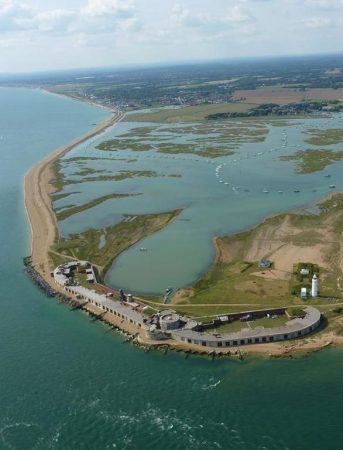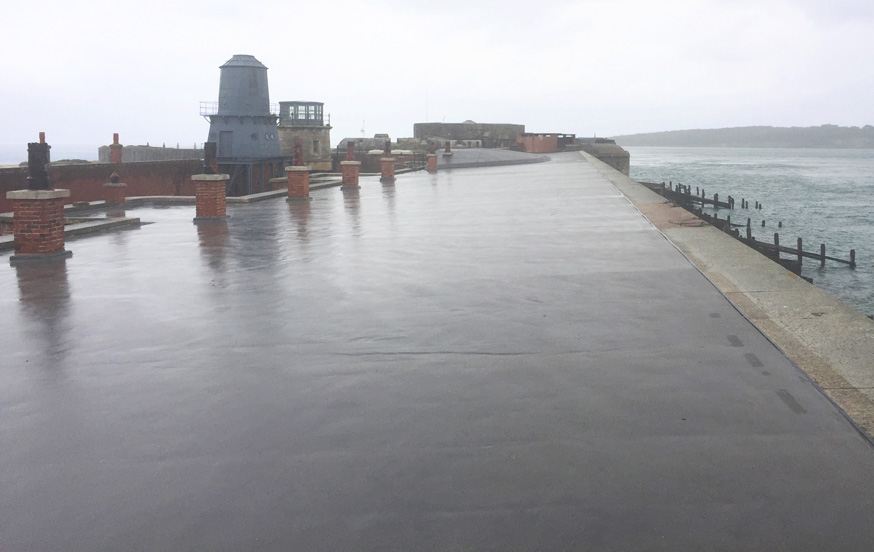With origins dating back to 1544, Hurst Castle was built by Henry VIII and at the time, it was one of the most advanced artillery fortresses in England. Located in Milford-on-Sea, the castle was used as a prison for eminent 17th century captives, and later strengthened during the 19th and 20th centuries.
It is one of the most well preserved of Henry VIII’s castles and one of a few of them to have been successively updated and strengthened, allowing it to retain an active military role in the 20th century. Following many structural additions and alterations, its last defensive role was in World War II.
Nowadays, Hurst Castle is open to the public and is established as one of Hampshire’s most popular visitor attractions. Situated at the seaward end of a shingle spit in the Solent, the end of the spit is located just three quarters of a mile from the Isle of Wight.
Hurst Castle is managed on behalf of English Heritage by Hurst Marine. As part of a major £1 million restoration project, an extensive refurbishment of the roof was scheduled by English Heritage and Historic England. The roof had previously been protected with mastic asphalt and had provided over 100 years’ effective weatherproof protection, but water ingress was starting to affect the structure.
Due to the outstanding performance of mastic asphalt over the years, mastic asphalt was again specified for the refurbishment of the roof in 2017 involving a 5,000m2 application of a polymer-modified mastic asphalt system manufactured by MAC member IKO Plc. Throughout the six month project, there was very close consultation between all parties – English Heritage, main contractor Heritage Building and Conservation (South), roofing specialist Infallible Systems, and IKO – from initial specification to final sign-off to ensure like-for-like replacements of the original materials. Plans had to be continually adjusted at short notice as variations in the materials and details were uncovered.
 Project Challenges
Project Challenges
This was a challenging project due to number of factors, the most significant of which was the logistics. The castle is located in a unique location whereby access was limited to ferries, and by pedestrians via a 1.5 mile gravel spit. Materials and waste had to be transported by tractor along the spit and then lifted on and off the roof by telehandler – including three two-tonne asphalt ‘cookers’, which were used to prepare the mastic asphalt. Everyone working on-site had to take the 20-minute ferry crossing to and from the castle, meaning work was more susceptible to delays than usual as a result of the often choppy conditions of the Solent.
Due to the exposed nature of the site, weather conditions were also a constant obstacle to the progress and completion of the works. As the refurbishment was carried out over a six month period, the weather fluctuated between hot sunshine and storms, with the applicators battling wind, rain and hail. Furthermore, the castle remained open to visitors throughout the project, adding an extra planning element to the safe execution of the project.
The work on the refurbishment project included significant mastic asphalt repairs throughout the west wing’s roof, while the roof on the east wing was completely stripped, then laid with 150 tonnes of sand and cement screed under 300 tonnes of mastic asphalt. Concrete repairs were also made to some structural cracks on the east wing. The only part of the roof that wasn’t worked on was the original Henry VIII round tower.
Ideal for Complex Detailing
The majority of the work was carried out on a significant fall from 10%-20% on the gun emplacements and there was a great deal of asphalt detailing required involving upstands, downstands, vertical areas, capping, drips and gutters. Mastic asphalt offers completely seamless waterproofing with long-term durability and stability across a wide temperature range. Its ease of installation and versatility are perfectly suited to complex, hand-laid projects, making it ideal for the detailing the Infallible Systems team – another MAC member – had to carry out.
The mastic asphalt system used for this project is backed by British Board of Agrément (BBA) certification, with fire performance standards in compliance with BS 476: Part 3: FAA. Mastic asphalt is carbon neutral and 10 years ago the mastic asphalt sector became the first industry in the world to achieve the CarbonZero standard. Mastic asphalt is 100% recyclable at the end of its useful life and it is able to be recycled and broken down into hardcore or used in roof screeds. It reduces carbon emissions and its seamless nature means it can be easily spot repaired, eliminating the need for costly wholesale replacement. Asingle-point insurance-backed guarantee covering materials, workmanship and design for up to 20 years was provided for this project.
In use for centuries, mastic asphalt has an illustrious history as one of the most established, well proven and durable waterproofing membrane systems currently available. The incorporation of polymers into modern mastic asphalt systems has helped lead to its resurgence in the construction industry. Particularly well suited for heritage applications, mastic asphalt has been specified for use on many high-profile heritage projects, including Westminster Cathedral, St Paul’s Cathedral, the Tower of London and Dover Castle.
Regardless of the extreme weather conditions, limited access and the very busy nature of the site, the refurbishment work was carried out using mastic asphalt safely, on time and to a very high standard, to the delight of all parties concerned. The application has allowed the roof of this stunning fortress to be restored to its former glory whilst ensuring effective weatherproof protection for many years to come.
To view this article in the latest edition of Roofing Today, please visit https://www.roofingtoday.co.uk/wp-content/uploads/2018/06/Roofing-Today-Issue-76-May-2018.pdf

